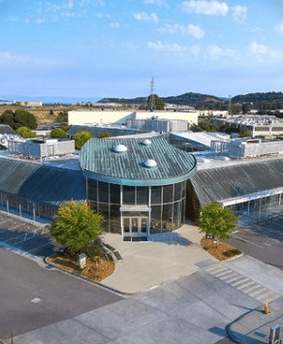 One of the County of Marin’s COVID-19 vaccination sites is on Kerner Blvd. in the Canal district. Courtesy image.
One of the County of Marin’s COVID-19 vaccination sites is on Kerner Blvd. in the Canal district. Courtesy image.
Eleven days since, it’s a decidedly mixed bag.
Restaurants and food-serving businesses, as well as the other local business sectors like salons and fitness facilities that serve as “multipliers” – that is, they create a ripple effect for surrounding businesses, with restaurant patrons shopping after a meal or grabbing a drink after getting their nails done or doing a spin class – are all back. And the incredibly popular downtown street closures will be activated each weekend that the weather allows.
Meanwhile, case counts have plummeted in Marin, the steepest decline over the past three weeks than we’ve had at any point during the COVID-19 crisis. “We don’t want to be falsely reassured by this, but it is a sign of the hard work of this community,” Marin County Public Health Officer Dr. Matt Willis told the Marin County Board of Supervisors this week.
But while the arrival of Super Bowl Sunday this weekend might serve as a boon for business activity, it rightly has Willis on pins and needles. “It’s the biggest threat right now,” he said. “We have seen really significant surges in cases after each holiday, and they’re not just little blips.”
And while another spike in COVID-19 cases would be terrible, it would be made even worse by the fact that Marin is on the verge of moving into the less restrictive red Tier 2 within the state’s Blueprint for a Safer Economy. That could happen as soon as mid-February, Willis said: “We are right now among the lowest of the counties in the state (in terms of case counts per 100,000 residents), and among the counties that are heading toward the red tier. We want to move into the red tier and get our kids back in school and get our economy on its feet. The red tier allows us to make progress.”
The red tier would allow a broader reopening that includes indoor dining at 25% percent capacity, which many Mill Valley restaurants have specifically planned for by redesigning their indoor spaces to allow for safer distances between employees, as well as deployment of commercial air filters to manipulate air flow to avoid aerosol-based disease transmission.
But that hope is tempered, again, by the continued sluggishness of vaccine distribution, with Marin receiving enough to only vaccinate approximately 1,000 people per week across Marin Public Health and all of Marin’s three major hospitals. Home to approximately 260,000 residents, Marin has vaccinated less than 36,000 to date, according to the latest data from the County of Marin. Those numbers mostly include healthcare workers, residents of long-term care facilities and Marin’s approximately 25,000 residents who are age 75 or above.
“The limited supply is the biggest issue right now,” Willis added. “We just don’t have the doses. We have the capacity to do 1,500 doses a day easy. We are not storing doses or holding back doses – we have the second highest vaccination rate per capita of any county in the state now.”
“The challenges are around supply,” Supervisor Damon Connolly added. “Vaccine doses are not sitting on the shelves or in the freezer. As they are received, they are being out into people’s arms.”
“We have no ability to independently procure vaccine,” either as a county public health office nor via our hospitals or healthcare facilities,” Willis said. “We are not able to obtain more doses.”
Unless that changes soon, vaccines in Marin could plummet even further. Weekly supplies need to continuously increase in order to continue vaccinating more people because those who have already received their first shot need to receive their second within four weeks, he said.
“We need to reset our expectations and match those with the supply that we receive,” Willis added. “It’s really just a matter of how quickly we are able to move, and it’s entirely dependent on how much vaccine we receive. If we don’t get more supply, we’re really well into March before we vaccinate all of our 75 and older residents. We need 500,000 doses, and it’s going to take us a long time to get through this.”
With that in mind, Willis emphasized that “the vaccine is not moving nearly quickly enough into Marin to be the solution to a surge in cases – it has to be our behavior. We need to be even more vigilant moving forward. Ultimately the answers are all of the protective measures we are using – we need to double down on them.”
While vaccines remain the critical issue, coronavirus variants are the topic du jour. “The variants are a real concern and there is no easy solution to the problem of mutations,” Willis said. “They aren’t more deadly, but they might be more infectious.”
Because of those variants, it will be prudent for us to take usual precautions even after we receive the vaccine, Willis said.
“For those that receive the vaccine, you need to continue to do what you had been doing before the vaccine,” he said. “Our success as a county is entirely dependent on the fact that, for the most part, our residents have been followed the necessary practices: wear masks, social distance and wash your hands.”


Trackbacks/Pingbacks